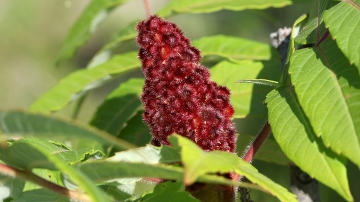Village News

PHOTO COURTESY OF GARRY KESSLER
A cluster of ripe staghorn sumac berries.
August 30, 2019, Page A4
NATURE NOTES
By Annie Reid
Westborough Community Land Trust
Sumac Season
Sumac-ade anyone? A few hundred years ago, the answer would have been “yes.” Today, few people even know what sumac-ade is. It’s a lemonade-like summer drink made from the red berries of our native sumac shrubs. New England colonists found out about the drink from Native Americans, and it’s sometimes called Indian lemonade.
You’ve probably seen sumacs along roadsides and in old fields and neglected open areas. Sometimes as tall as small trees, sumac shrubs become noticeable in late July and early August. That’s when their upright clusters of berries ripen to dark red.
In early fall, another color change follows, as sumac leaves turn bright scarlet, telling wildlife that the fruit is ready to eat (and to spread the sumac seeds in their droppings). In winter, sumacs lose their leaves but the berry clusters last until birds can no longer find better food. The greenish white blossoms of most sumacs are inconspicuous in late spring or early summer.
We have four sumacs in our area. All are in the cashew family (Anacardiaceae). They include two near look-alikes: staghorn sumac (Rhus hirta, Rhus typhina) and smooth sumac (Rhus glabra). There’s also winged or shining sumac (Rhus copalllinum). These three have red berries traditionally used for sumac-ade.
Staghorn sumac has its odd name because its upper branches and twigs resemble deer antlers in the way they fork and in their dense covering of hairs like the “velvet” on developing deer antlers. Smooth sumac is so named because it lacks these hairs, so it has smooth twigs.
Winged or shining sumac has dark green, shiny leaflets with wings on the stems between them. It is sometimes suggested for gardens as a native alternative to invasive shrubs such as burning bush (Euonymus alatus).
The fourth sumac in our area is the less closely related poison sumac (Toxicodendron vernix, Rhus vernix). Its white berries look similar to those of poison ivy (Toxicodendron radicans), and all parts of this shrub cause a rash like poison-ivy (or worse). Needless to say, the white berries are not suitable for sumac-ade.
Fortunately, we’re not likely to encounter poison-sumac because it is found in bogs and wooded swamps, where most of us don’t go.
How is sumac-ade made? The key ingredient is the acidic, sticky coating on the red berries and their hairs. It contains malic acid (also found in apples), tannins (also found in tea), and vitamins A and C. It’s best to get the berries fairly soon after they ripen –before insects move in – and not right after a heavy rain (which may wash away the coating).
To make sumac-ade, pick about half a dozen (6) red berry clusters and put them in a half-gallon of cold or cool water – not hot water, which will bring out bitterness. Rub and gently squeeze the berries (in the water) to loosen the hairs and coating. Let them soak for 5 to 15 minutes, then pour the light pink liquid through a cheesecloth to strain out the hairs. Sumac-ade is tart and can be sweetened.
Sumacs are largely unsung today, but in the past their leaves, bark, stems, roots, and berries had numerous medicinal and practical uses. Teas were made to treat mouth sores, sore throats, diarrhea, worms, dysentery, asthma, and more. Washes were used on wounds and burns. People chewed twigs for mouth health. Bark tannins were used to tan leather and as a dye ingredient.
Sumac berries are food for winter birds (wild turkeys, chickadees, blue jays, cardinals, robins, and more). Deer, cottontail rabbits, and mice munch on stems and trunks. Bees and butterflies nectar at the spring blossoms.
Enjoy knowing about sumac-ade and watching our local sumacs throughout the seasons.